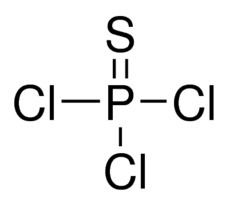Formula Cl3PS Density 1.67 g/cm³ Melting point -35 °C | Molar mass 169.4 g/mol Boiling point 125 °C Appearance Colorless liquid | |
 | ||
Thiophosphoryl chloride is an inorganic compound with the formula PSCl3. It is a colorless liquid with a pungent odor that fumes in moist air. It is synthesized from phosphorus chloride and used to thiophosphorylate organic compounds, such as to produce insecticides.
Contents
Synthesis
Thiophosphoryl chloride can be generated by several reactions starting from phosphorus trichloride. The most common and practical synthesis, hence used in industrial manufacturing, is directly reacting phosphorus trichloride with excess sulfur at 180 °C.
PCl3 + S → PSCl3Using this method, yields can be very high after purification by distillation. Catalysts facilitate the reaction at lower temperatures, but are not usually necessary. Alternatively, it is obtained by combining phosphorus pentasulfide and phosphorus pentachloride.
3 PCl5 + P2S5 → 5 PSCl3Reactions
PSCl3 is soluble in benzene, carbon tetrachloride, chloroform, and carbon disulfide. However, it hydrolyzes rapidly in basic or hydroxylic solutions, such as alcohols and amines, to produce thiophosphates. In water PSCl3 reacts, and contingent on the reaction conditions, produces either phosphoric acid, hydrogen sulfide, and hydrochloric acid or dichlorothiophosphoric acid and hydrochloric acid.
PSCl3 + 4 H2O → H3PO4 + H2S + 3 HClPSCl3 + H2O → HOP(S)Cl2 + HClPSCl3 is used to thiophosphorylate, or add P=S, organic compounds. This conversion is widely applicable for amines and alcohols, as well as amino alcohols, diols, and diamines. Industrially, PSCl3 is primarily used to produce insecticides, like parathion.
PSCl3 + 2 C2H5OH → (C2H5O)2PSCl + 2 HCl(C2H5O)2PSCl + NaOC6H4NO2 → (C2H5O)2PSOC6H4NO2 + NaClPSCl3 reacts with tertiary amides to generate thioamides. For example:
C6H5C(O)N(CH3)2 + PSCl3 → C6H5C(S)N(CH3)2 + POCl3When treated with methylmagnesium iodide, it give tetramethyldiphosphine disulfide ([Me2P(S)].2.
